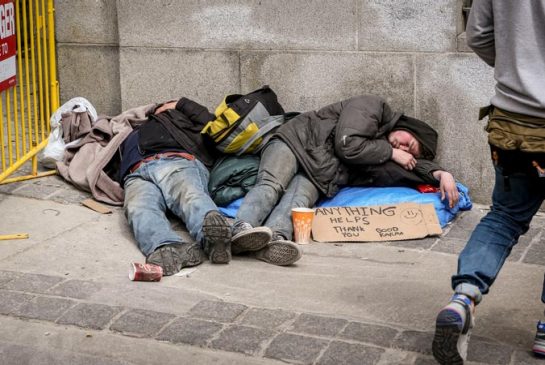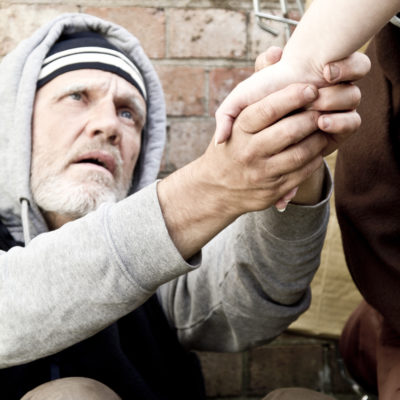OUT OF THE COLD STORIES

Packed Toronto homeless shelter system poised for breakdown: Report
Toronto’s crowded shelter system is “lurching towards breakdown” as it routinely turns away scores of homeless people the city purports to protect, according to findings in a new report compiled by the Ontario Coalition Against Poverty.
“Fundamentally, the Toronto shelter system and its backup component are not ensuring that everyone who needs it will have shelter on any given night,” according to a copy of the report obtained by the Star.
“The conditions being imposed on those who do access the system are utterly failing to meet basic needs, provide health sustaining facilities and offer conditions that respect human dignity.”
A team of eight volunteer investigators spent the week of Jan. 18 interviewing people unable to get a bed in a city-administered shelter or who refused to use shelters and, therefore, had to find a space in Toronto’s “backup component.” That backup comprises Out of the Cold charitable programs and city-run warming centres. In both, people can get a meal, a mat to sleep on the floor, and a blanket.
Some of the 105 people interviewed told investigators they don’t use the shelter system and prefer the less restrictive atmosphere of Out of the Cold programs and warming centres.
One “alarming” statistic in the report: 81 per cent of those interviewed stated they’d been denied a shelter bed either during the survey week or previously, because city shelters were full. Total shelter capacity is 4,374 (for youth, women, men and families), according to the city’s daily shelter census data.
During the January survey, 38.5 per cent of respondents said they couldn’t get city shelter beds that week because facilities were at capacity. A further 14.3 per cent said they were barred for a period of time from using city shelters (for various rule violations) and turned to these other programs.
On Wednesday, Ontario Coalition Against Poverty members and supporters plan to deliver the report to city hall, following an 11 a.m. march that begins at Sherbourne and Queen Sts. The group will urge Mayor John Tory to take action on a list of demands: Provide new shelter spaces, including opening federal armouries for emergency beds; prevent further loss of shelter beds and protect existing social housing “at risk,” while working to expand affordable housing.
Jessica Hales, a Toronto nurse practitioner who works in the inner city, was one of the report investigators. She calls the state of the city shelters “a crisis situation” that compels those denied emergency beds to sleep on the street or in stairwells, or remain in unsafe relationships if they can’t find other accommodation.
“The city is aware of these issues and is not doing much about it. When you raise these issues, you just get a bureaucratic response,” Hales said.
The report also states that Out of the Cold programs (inter-faith charity-based shelters run during winter) and cold-weather warming centres “are struggling to meet need.”
The reporting team found 55 per cent of respondents said they’d been denied overnight access to Out of the Cold programs at some point because a particular facility was full.
“Numerous people” also told investigators that these programs and warming centres sometimes run out of mats and blankets, “forcing people to sleep on the bare floor or in chairs.”
Hales said that in the first half of January, an average of 100 people a night stayed at Out of the Cold programs, which shows “the city depending on volunteer services to fill a gap.”
OCAP’S FINDINGS
An Ontario Coalition Against Poverty team visited eight inter-faith Out of the Cold facilities and two warming centres in the GTA during the week of Jan. 18. Eight volunteer investigators observed facility conditions and interviewed a total of 105 “service users” over that week to gather information for the OCAP report. Here are some of the survey findings:
Question: Why are you at an Out of the Cold facility or warming center? (91 respondents)
Shelters are full: 38.5 per cent
Out of the Cold/warming centres easier to access: 16.4 per cent
Barred from shelter: 14.3 per cent
Unfriendly staff at shelter: 14 per cent
Past experience of theft at shelter: 13 per cent
Past experience of bugs (bed bugs, lice, scabies) at shelter: 9.8 percent
Poor food quality at shelter: 8.7 per cent
Question: Have you ever been kicked out/or barred from a shelter? (92 respondents)
YES:
Drug/alcohol use/intoxication: 60.8 per cent
Assault: 12 per cent
Curfew violation: 9.7 per cent
Verbal abuse: 7.6 per cent
Other/unknown: 10.8 per cent
NO: 44.5 per cent
CONDITIONS:
OCAP found none of the Out of the Cold facilities or warming centres fully complied with Toronto shelter standards.
Several locations did not have one toilet for every 15 people
Mats on floors were the “best” sleeping option at all locations.
All locations offered one blanket. Two offered pillows.
Space between mats ranged from a few inches (at three surveyed locations) to two feet (one location), “placing people at risk of infectious diseases and posing safety issues if evacuation became necessary.” Toronto Shelter Standards “highlight the importance of allowing 2.5 feet between sleeping surfaces.”
SHELTER OUTBREAKS
There have been 18 documented illness outbreaks at city shelters from 2010 to 2015. Some, such as bouts of food poisoning and norovirus, affected about 70 men at a time in Seaton House.
In total, 660 men and women using shelters became sick during these outbreaks.
Norovirus: 7 confirmed outbreaks
Gastroenteritis: 6 confirmed outbreaks
Food poisoning: 3 confirmed outbreaks
Influence (H3): 1 confirmed outbreak
Streptococcus pneumonia: 1 confirmed outbeak
OCAP DEMANDS
OCAP’s “March on City Hall” begins 11 a.m. Wednesday at Queen and Sherbourne Sts., to deliver OCAP’s shelter system report to Mayor John Tory. These “demands” stem from the week-long survey in January:
1. Enforce the shelter system’s 90 percent maximum occupancy policy:
“The ongoing refusal to enforce the 90 percent maximum occupancy by opening additional space must come to an end. It is the key meaningful improvement in a deplorable and deteriorating situation. Unless there are enough shelter beds to meet the need that exists, people will be forced onto the streets or continue to endure conditions that no one should have to face.”
2. Immediately open new spaces to shelter people, including the Federal Armouries:
“Such a move would have an immediate beneficial effect and would provide access to beds, cots, pillows, showers and improved personal space and safety.”
3. End discriminatory practices within the shelter system:
“A low-barrier access approach must be taken to ensure that people are not removed or barred from shelters . . . this vital approach requires adequate spaces be provided or the tensions created by overcrowding will continue to stand in the way of a system that can meet people’s needs and be truly inclusive.”
4. No further loss of shelter beds:
“The crisis in the system is such that no existing space can be put in jeopardy. This is especially true in the central part of the city where shelters are needed the most.”
5. Respect the right to housing:
“There remains an acute need for all levels of government to put real resources into social housing and, in addition, it is vital that the city of Toronto not compound the problem by putting existing housing at risk.”

